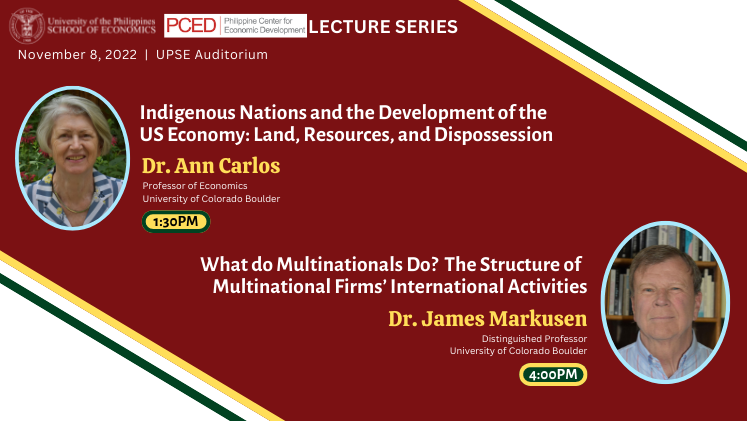Join the UP School of Economics on its lecture series featuring studies titled "Indigenous Nations and the Development of the US Economy: Land, Resources, and Dispossession" by Dr. Ann Carlos and "What do Multinationals Do? The Structure of Multinational Firms' International Activities" by Dr. James Markusen on November 8, 2022, via Zoom and onsite.
Onsite registration: https://docs.google.com/forms/d/e/1FAIpQLSfQzf2scL_H7ceXAExug-UJhRhq4FvCzHjihQsnzsSlanVeBg/viewform
Zoom Registration: https://zoom.us/webinar/register/WN_WEi00R-MTBacxP45lBiqfQ?fbclid=IwAR2SZENG7Cf6Y0pb0hJVyONaL4f1W4yWvjhNPwT5PwutRkH5ugUAWnHxqbs
You may read the abstracts here:
Dr. Ann Carlos
Indigenous Nations and the Development of the
US Economy: Land, Resources, and Dispossession
Abundant land and strong property rights are conventionally viewed as key factors underpinning U.S. economic development success. This view relies on the “Pristine Myth” of an empty undeveloped land, but the abundant land of North America was already made productive and was the recognized territory of sovereign Indigenous Nations. We demonstrate that the development of strong property rights for European/American settlers was mirrored by the attenuation and increasing disregard of Indigenous property rights. We argue that the dearth of discussion of the dispossession of Indigenous nations results in a misunderstanding of some of the core themes of U.S. economic history.
Dr. James Markusen
What do Multinationals Do?
The Structure of Multinational Firms’ International Activities
Analyses of multinational enterprises have generally shifted from a
capital-market perspective to viewing them as real production units. Yet, we still have difficulties in answering a basic question: What do multinational enterprises do? Here, we seek some broad, general answers about the structure of multinational firms’ international activities. By structure, we include (a) the geographic distribution of a firm's activities, (b) activities performed by various branches, (c) where do foreign affiliates sell their outputs and purchase their inputs and (d) interactions among establishments. Much of our analysis relates to which of two archetypes is dominant: (1) horizontal structures in which foreign affiliates replicate the firm's core activities and serve local and regional markets and (2) vertical structures in which foreign affiliates perform different activities and act as links in a global production chain.

